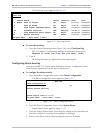
Appendix B Traffic Separation RIC-155 Installation and Operation Manual
B-2 Port-Based/VLAN-Based Traffic Separation
MNG Host
Uplink
Data
Figure B-2. Physical Port Access –MNG Only
All
When the physical port access is set to All, the internal bridge connections allow
both local and remote RIC-155s to be managed via the MNG and DATA ports.
MNG
Host
Uplink
Data
Figure B-3. Physical Port Access – All
Local Mng Only
When the physical port access is set to Local Mng Only, the internal bridge
connections allow only the local RIC-155 to be managed via the MNG and DATA
ports.
MNG Host
Uplink
Data
Figure B-4. Physical Port Access – Local Mng Only
B.2 Port-Based/VLAN-Based Traffic Separation
The main purpose of traffic separation is to prevent management frames from
entering data ports of the local and remote units. The traffic separation mechanism
can be further improved by using internal VLAN-based routing. Management and
data Ethernet ports receive unique VIDs (VLAN Identifiers), which define frame
routes inside the bridge.
Default port VIDs are set as follows:
• Management port – 1
• Data port – 2.


















